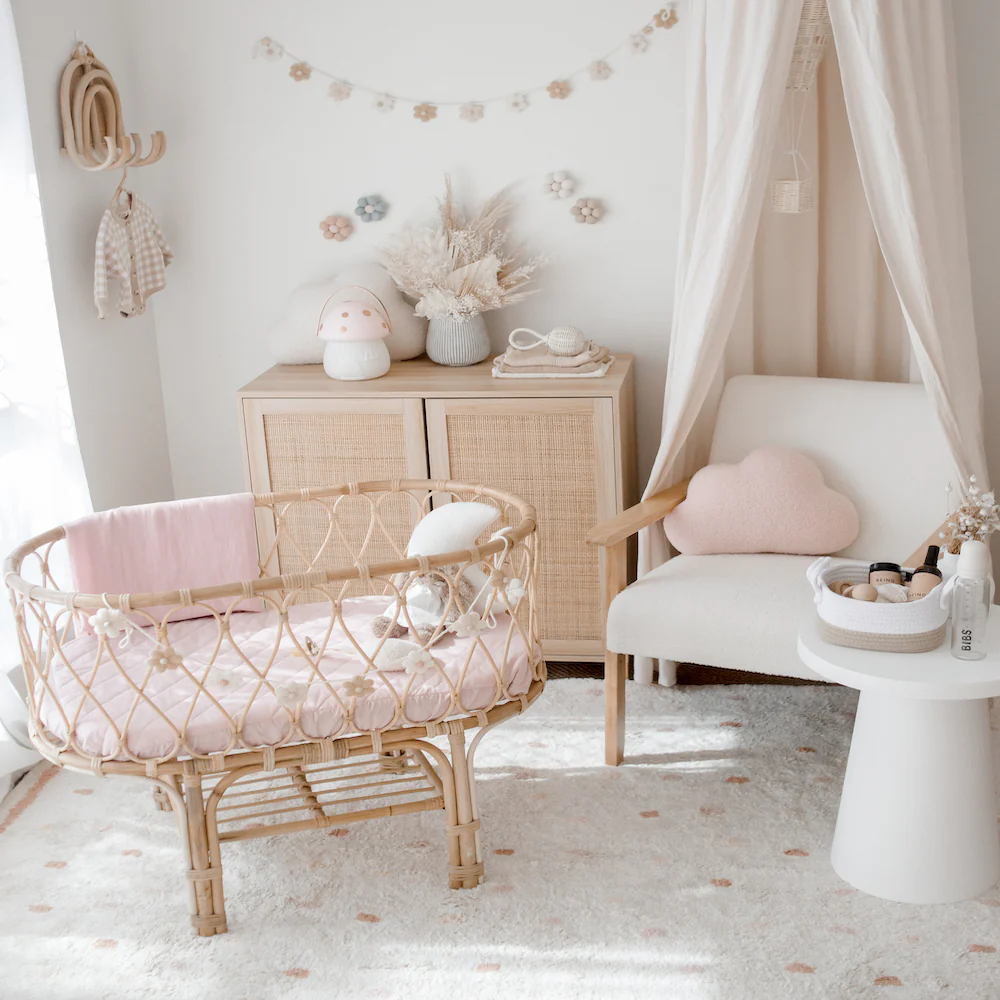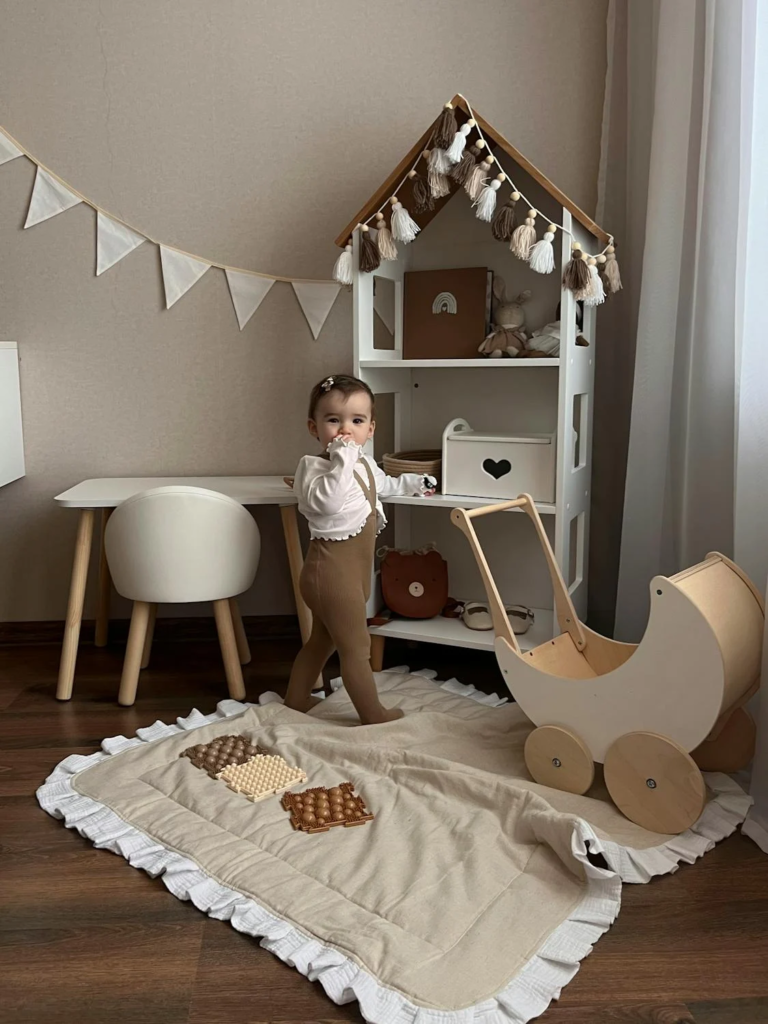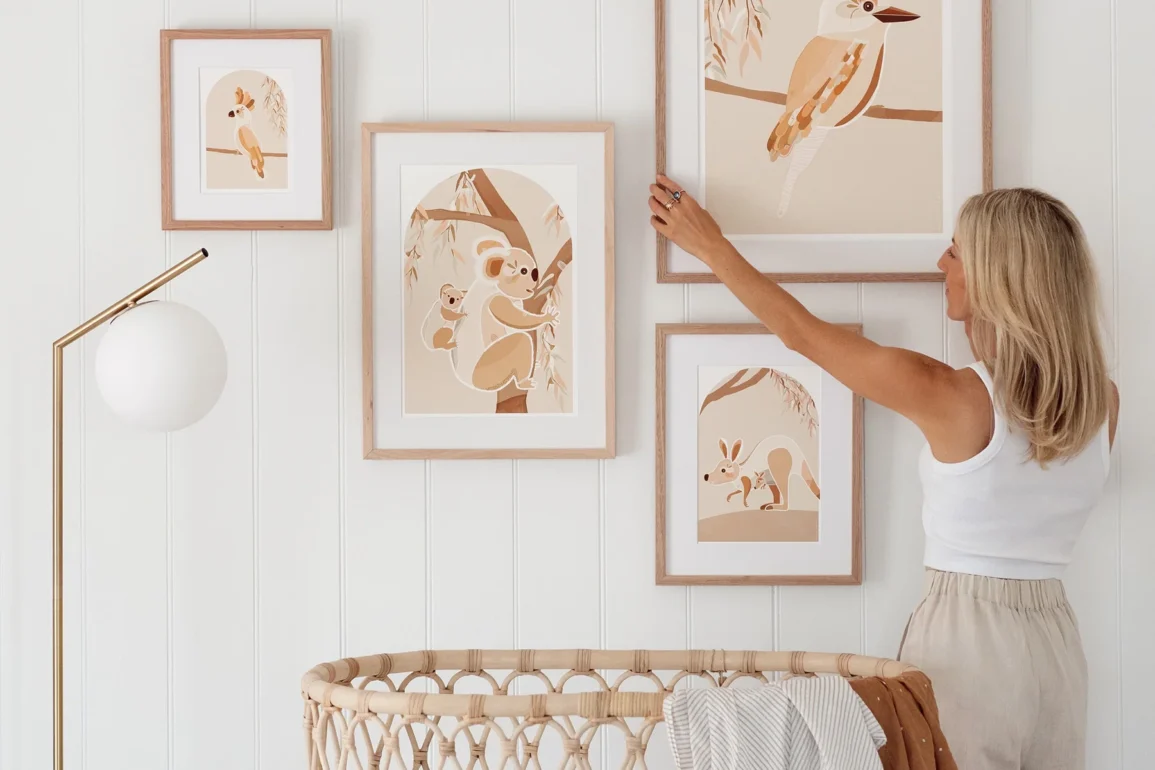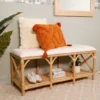Boho design isn’t a trend—it’s a lifestyle aesthetic rooted in freedom, craftsmanship, nature, and storytelling. In a nursery, it’s less about following a rigid style guide and more about creating a space that feels layered, soulful, and lived-in. The hallmark? Nothing looks mass-produced. Instead, each piece—from the crib to the mobile—feels collected, personal, and rich in texture.
Unlike traditional nursery styles that often lean into “babyish” themes, boho nurseries borrow from global influences, vintage nostalgia, and organic elements. Think: natural fibres, earthy tones, soft textiles, and pieces that carry emotional resonance—whether they’re handmade, passed down, or simply feel like they belong.
And while the look can be whimsical or minimal, bold or soft, what unites all great boho nurseries is intention. It’s about creating a space that feels not just beautiful, but grounding. A room that evolves as your baby grows. A place that reflects your values—whether those are slow living, sustainability, artistry, or comfort.
Now that you know what boho nursery design is really about—not just a look, but a layered, soulful approach to space—let’s explore 15 ideas that bring it to life beautifully.
1. Embrace Woven Elements as Both Structure and Softness

Wicker, rattan, and seagrass aren’t just “boho by association”—they’re materials that bring organic grounding to a space. In nurseries, they’re particularly useful because they soften harsh angles and add visual warmth without overwhelming small rooms. A rattan moses basket or woven pendant light doesn’t just look stunning; it also sets a quiet, earthy tone that keeps the room feeling breathable.
From a practical lens, woven baskets and ottomans also double as hidden storage—essential for stashing everything from swaddles to stuffed toys without creating chaos. Choose baskets with lids to keep things tidy, and avoid anything too flimsy (loose weave = baby fingers stuck). The goal is beauty you can live with—safely.
2. Use Minimalist Neutrals to Create Calm That’s Actually Livable
Boho nurseries thrive on a grounded base palette, but here’s the catch: beige isn’t a design solution on its own. A warm, minimalist nursery still needs to feel dimensional. The trick is layering. Try a creamy base colour on the walls, but break it up with contrasting materials: a cane crib, a wool rug, a clay wall sconce.
This approach gives your eyes places to rest but never feels flat. And it’s incredibly adaptable—meaning when your baby grows into a toddler, you’re not repainting everything. You’re simply swapping out a pillow or a print.
3. Add Greenery (And Keep It Baby-Safe)
Yes, greenery brings life—but in a nursery, it also helps soften corners and fill vertical space. Hanging a pothos near the window or placing a faux eucalyptus branch on a shelf draws the eye upward and breaks up visual dead zones.
Just be mindful: real plants should always be out of reach of crawling babies or curious toddlers. Choose non-toxic varieties, or opt for quality faux plants that still offer texture without risk. And always secure planters so they can’t be pulled over. Greenery should feel easy—not like another thing to worry about.
4. Go for a Canopy or Tulle Accent That Adds Shape, Not Fuss
Canopies are beautiful, but in nurseries, they’re also a commitment. Done right, they elevate the space with softness and vertical movement. Done wrong, they collect dust and feel fussy.
The best use? Above a reading nook or crib, but away from airflow vents and ceiling fans. Choose breathable materials like cotton voile or linen, and anchor securely. If you want the dreamy look without full draping, try a minimalist hoop canopy or even a soft draped fabric pinned above a chair. It’s about shaping the air, not crowding it.
5. Elevate Walls With Thoughtful Boho Decor (That Can Grow With Your Baby)

Nursery walls often get overlooked or overly themed. The boho approach is more layered. Think of your wall as a mini gallery—where texture, tone, and storytelling take the lead.
Rattan wall decor, handwoven hangings, muted rainbow murals, and abstract art prints all work—if they’re chosen with scale and age adaptability in mind. Avoid overcrowding the space. Leave room for evolution. And hang everything securely, well above the reach of tiny hands.
Pro tip: choose décor you’d want in another room of the house. That way, you know it’ll outlast the nursery stage.
6. Rethink Macramé as an Accent, Not a Theme
Macramé often gets overused in boho spaces—but when used with intention, it’s magic. A single wall hanging can balance a stark wall. A macramé mobile above the crib can introduce handcrafted movement without hard edges.
But it’s also important to edit. Avoid overly fringe-heavy pieces in areas where they’ll gather dust or droop. Instead, treat macramé like a statement necklace—it should accent the space, not define it.
7. Let Vintage and Retro Pieces Ground the Room
Here’s where the nursery really starts to feel like yours. A vintage dresser repurposed as a changing station. A wooden rocking horse from a grandparent’s attic. A mid-century bookshelf found at a market.
The beauty of vintage is that it brings in soul and sustainability. But remember: it has to work. Always check older furniture for stability, lead-free finishes, and secure fastenings. And don’t be afraid to mix eras—a 70s woven light fixture looks incredible above a sleek modern crib if the tones tie together.
8. Choose Wallpaper or Murals That Tell a Story (Not Just Look Cute)
Statement wallpaper isn’t just trendy—it’s smart. It anchors the space, sets mood, and gives you a visual focal point without adding more stuff. But the key is to skip the literal and lean into the atmospheric.
Celestial patterns, gentle arches, painterly florals, and abstract geometrics all work beautifully. If you’re painting a mural, think about shapes that grow with your child—things that feel enchanting at any age. Avoid cartoons or bright primaries unless you’re going full maximalist and know how to balance it.
9. Ground the Palette With Earth Tones That Feel Nourishing

Boho nurseries really shine when they borrow from nature’s palette. Instead of baby pink or powder blue, think rust, ochre, sage, stone, and clay. These colours feel soft but rich—and most importantly, they don’t age out when your child turns two.
Use colour in zones. A sage wall here, a rust cushion there. If the overall tone stays muted and cohesive, you can afford to play with pops of texture and colour elsewhere without it becoming chaotic.
10. Think in Layers—But Make Them Work for Real Life
Texture is the soul of boho—but don’t just layer for the sake of it. Every piece should serve a purpose. That crocheted pouf? Maybe it’s also your footrest. The embroidered quilt? Used during night feeds. The shag rug? Soft enough for tummy time and washable, ideally.
You want the room to invite touch, not feel like it’s constantly being “fixed.” Design from the floor up, with pieces that feel forgiving, not fragile.
11. Use Nature Themes Subtly and Sustainably
You don’t need a safari mural or mushroom-printed wallpaper to nod to nature. A wool lamb rocker, a botanical print, or a wooden mobile can suggest the wild without getting overly literal. Try one motif and repeat it gently—perhaps a leaf pattern on a rug echoed in the wall art.
These quiet connections to nature ground the space emotionally while leaving room for evolution. They don’t box your child into a theme—they create a world they can grow into.
12. Design With Rituals in Mind (Not Just Aesthetics)
The most memorable nurseries aren’t just stylish, they’re shaped around the small, meaningful rituals of early parenthood. In boho design, this means carving out space for connection. A thoughtfully placed feeding chair beside a dimmable lamp. A nook with floor cushions for bedtime stories. A woven memory box for storing little milestones—hospital tags, first curls, handwritten notes.
When designing your boho nursery, think beyond layout. Think rhythm. Where will you slow down? Where will you hold, rock, and soothe? These questions turn a beautiful room into a deeply personal space that supports not just your baby—but you
13. Maximalist? Go Curated, Not Cluttered
Boho maximalism is beautiful when done well—but it takes discipline. Instead of filling every surface, think of the room in visual clusters. Let colours and textures repeat. Group items by tone or material, not just whim.
The most compelling maximalist nurseries have rhythm. They move your eye from one detail to the next—but always offer a moment to rest.
14. Or Soften Everything with Romantic Boho

For a more serene take, romantic boho leans into soft light, blush tones, and delicate materials. Think cane cribs, brass lighting, vintage wallpaper, and gauzy curtains. It’s quiet but deeply personal. Perfect if you want a space that feels dreamy without being overly precious.
Design-wise, this palette lets you shift easily into toddler years without a full rework. Add in a toddler bed, swap the rug—and the mood still holds.
15. Finish with Something Whimsical That Moves
Mobiles are more than décor—they’re often your baby’s first visual stimulation. Choose one that feels artistic and calming: floating moons, stitched clouds, or origami birds. It’s the final layer—the piece that ties the air in the room together.
Boho nursery design isn’t about copying a look. It’s about curating a space that feels soulful, adaptable, and made for real life. Whether your vibe is minimalist, maximalist, or somewhere in between, a truly great boho nursery is one where both you and your baby can exhale.


